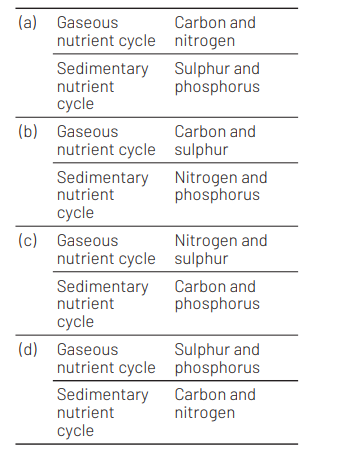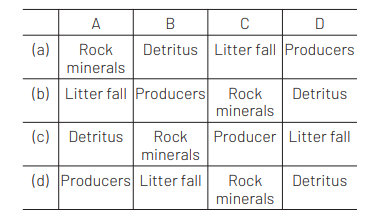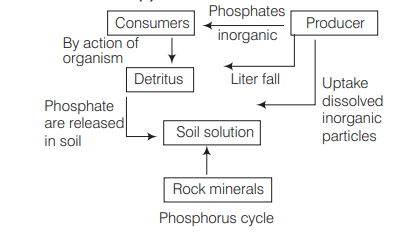Question
The amount of nutrients, such as carbon, nitrogen, phosphorus and calcium present in the soil at any given time, is referred as [NEET 2021]
(a) climax
(b) Climax community
(c) standing state
(d) standing crop
Answer/Explanation
Ans. (c)
Standing state is the amount of biogenetic nutrients present at any specific time in the ecosystem. The whole living matter is composed of nutrients Like carbon, nitrogen and so on.
Other options can be explained as: Climax, in ecology, is the final stage of biotic succession attainable by a plant community in an area under the environmental conditions present at a particular time.
A climax community is one that has reached the stable stage. When extensive and well-defined, the climax community is called a biome. Examples are tundra, grassland, desert, and the deciduous, coniferous and tropical rain forests. Each trophic level contains certain mass of living matter at a specific time is called standing crop.
Question
Which of the following statements is incorrect regarding the phosphorus cycle? [NEET (Oct.) 2020]
(a) Phosphates are the major form of phosphorus reservoir
(b) Phosphorus solubilising bacteria facilitate the release of phosphorus from organic remains
(c) There is appreciable respiratory release of phosphorus into atmosphere
(d) It is sedimentary cycle
Answer/Explanation
Ans. (c)
Staement (c) is incorrect and can be corrected as Phosphorus cycle is a type of sedimentary cycle, i.e. it main reservoirs are soil and rocks. It is mainly found as phosphates in rocks. During this cycle phosphorus solublising bacteria like Pseudomonas, Acetobacter, etc., help to release phosphorus from organic remains. A large amount of phosphate is lost in sea by sedimentation. There is no respiratory release of phosphorus into atmosphere because phosphorus is an inorganic nutrient that does not take part in respiration.
Question
In which of the following both pairs have correct combination? [CBSE AIPMT 2015]

Answer/Explanation
Ans. (a)
The biogeochemical cycles are of two types, i.e. gaseous cycles, in which the reservoir for the nutrient elements is in the atmosphere (air) or hydrosphere (water). The four most abundant elements in the living systems, i.e. hydrogen, carbon, oxygen and nitrogen have predominantly gaseous cycles. In sedimentary cycles, the reservoir for the nutrient elements is in the sediments of the earth. Elements, such as phosphorus, sulphur, potassium and calcium have sedimentary cycles.
Question
Given below is a simplified model of phosphorus cycling in a terrestrial ecosystem with four blanks (A-D). Identify the blanks [CBSE AIPMT 2014]

Answer/Explanation
Ans. (c)

Question
Natural reservoir of phosphorus is [NEET 2013]
(a) rock
(b) fossils
(c) sea water
(d) animal bones
Answer/Explanation
Ans. (a)
The natural reservoir of phosphorus is in phosphate rocks. Phosphate is added in small amount into the cycling pool through weathering of rocks. Phosphate circulate in the abiotic environment in lithosphere as well as hydrosphere.
Question
Which one of the following is not a gaseous biogeochemical cycle in ecosystem? [CBSE AIPMT 2012]
(a) Sulphur cycle
(b) Phosphorus cycle
(c) Nitrogen cycle
(d) Carbon cycle
Answer/Explanation
Ans. (b)
Phosphorus cycle is a sedimentary biogeochemical cycle. It describes the movement of phosphorus through the lithosphere, hydrosphere and biosphere and the main reservoir pool is lithosphere.
Atmosphere does not play any significant role in the movement of phosphorus because phosphorus and phosphorus based compounds are usually solids at the typical ranges of temperature and pressure found on earth. The production of phosphine gas occurs only in specialised, local conditions.
Question
About $70 \%$ of total global carbon is found in [CBSE AIPMT 2008]
(a) grasslands
(b) agroecosystems
(c) oceans
(d) forests
Answer/Explanation
Ans. (c)
Sea water contains 50 times more $\mathrm{CO}_2$ than air. i.e. about $70 \%$ of total global carbon is found in oceans. This is in form of carbonates and bicarbonates. The atmosphere is the source of $\mathrm{CO}_2$. which is utilised by plants in photosynthesis reduced to form carbon compounds. The total mass of carbon currently in the atmosphere is about $7 \times 10^{17} \mathrm{~g}$, i.e. 700000 million tonnes. Oceans regulate the $\mathrm{CO}_2$ content in the atmosphere and thus, play a very important role.
Question
Which one of the following pair is mismatched? [CBSE AIPMT 2005]
(a) Biomass burning- Release of $\mathrm{CO}_2$
(b) Fossil fuel burning – Release of $\mathrm{CO}_2$
(c) Nuclear power – Radioactive wastes
(d) Solar energy – Green house effect
Answer/Explanation
Ans. (d)
Solar energy is not responsible for green-house effect instead it is a source of energy for the plants and animals. Green plants prepare their food by the use of this solar energy. $\mathrm{CO}_2$ gas is mainly responsible for greenhouse effect. Excess of this gas forms a thick layer around the earth and prevents re-radiation of earth climate entering sun rays to atmosphere. Thus, functions like the glass pannels of a green house (or the glass windows of a motor car). This is thus, called greenhouse effect.
Question
If by radiation all nitrogenase enzymes are inactivated, then there will be no [CBSE AIPMT 2004]
(a) fixation of nitrogen in legumes
(b) fixation of atmospheric nitrogen
(c) conversion from nitrate to nitrite in legumes
(d) conversion from ammonium to nitrate in soil
Answer/Explanation
Ans. (c)
The rate of total capture of energy or the rate of total production of organic material is gross primary productivity while the balance or biomass remaining after meeting the cost of respiration of producers is net primary productivity. Hence, gross productivity has highest value in grassland ecosystem.
Question
Which of the following pair is a sedimentary type of biogeochemical cycle? [CBSE AIPMT 1995]
(a) Oxygen and nitrogen
(b) Phosphorous and sulphur
(c) Phosphorous and nitrogen
(d) Phosphorus and carbon dioxide
Answer/Explanation
Ans. (b)
In sedimentary cycle the reservoir for the elements is in the sediments of earth (lithospherel e.g. phosphorus, calcium, magnesium, sulphur.
Question
The main role of bacteria in the carbon cycle involves [CBSE AIPMT 1998]
(a) photosynthesis
(b) chemosynthesis
(c) digestion or breakdown of organic compounds
(d) assimilation of nitrogenous compounds
Answer/Explanation
Ans. (c)
Huge amount of plants, animals and human wastes are decomposed by bacteria and fungi present in environment and large quantity of $\mathrm{CO}_2$ necessary for photosynthesis is released into the atmosphere.
Question
Bulk $\mathrm{CO}_2$-fixation occurs in [CBSE AIPMT 1994]
(a) crop plants
(b) oceans
(c) tropical rain forests
(d) temperature forests
Answer/Explanation
Ans. (b)
Bulk $\mathrm{CO}_2$-fixation occurs in oceans. The productivity of ocean ecosystem is very high, here phytoplanktons, e.g. diatoms are the greatest producers.
